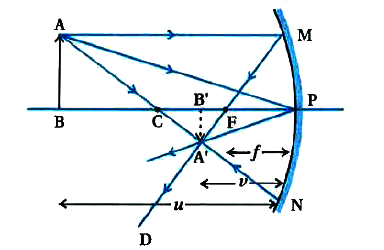Answer the following questions:
(d) Does the apparent depth of a tank of water change if viewed obliquely? If so, does the apparent depth increase or decrease? Solution in Gujrati
The depth observed by looking obliquely is less than the depth observed by looking normally. To understand this refer Answer of Que. 24 of Section - A.
Topper's Solved these Questions
- RAY OPTICS AND OPTICAL INSTRUMENTSBOOK - KUMAR PRAKASHANCHAPTER - RAY OPTICS AND OPTICAL INSTRUMENTSEXERCISE - SECTION-B (NUMERICALS)(NUMERICAL FROM .DARPAN. BASED ON TEXTBOOK )
12 Videos
- RAY OPTICS AND OPTICAL INSTRUMENTSBOOK - KUMAR PRAKASHANCHAPTER - RAY OPTICS AND OPTICAL INSTRUMENTSEXERCISE - SECTION-C (NCERT EXEMPLAR SOLUTION) (MULTIPLE CHOICE QUESTIONS (MCQs))
16 Videos
- RAY OPTICS AND OPTICAL INSTRUMENTSBOOK - KUMAR PRAKASHANCHAPTER - RAY OPTICS AND OPTICAL INSTRUMENTSEXERCISE - SECTION-B (NUMERICALS)(NUMERICAL FROM TEXTUAL ILLUSTRATIONS)
17 Videos
- MOVING CHARGES AND MAGNETISMBOOK - KUMAR PRAKASHANCHAPTER - MOVING CHARGES AND MAGNETISMEXERCISE - SECTION D (MCQs ASKED IN COMPETITIVE EXAMS)
34 Videos
- SAMPLE QUESTION PAPER BOOK - KUMAR PRAKASHANCHAPTER - SAMPLE QUESTION PAPER EXERCISE - PART-B SECTION-C
5 Videos
Similar Questions
As shown in the figure, a thin rod AB of length 10 cm is placed on the principal axis of a concave mirror such that it.s end B is at a distance of 40 cm from the mirror. If the focal length of the mirror is 20 cm, find the length of the image of the rod

View SolutionA ray of light incident at an angle θ on a refracting face of a prism emerges from the other face normally. If the angle of the prism is 5∘ and the prism is made of a material of refractive index 1.5, the angle of incidence is
View SolutionSuppose that the lower half of the concave mirror.s reflecting surface as shown in figure is covered with an opaque (non-reflective) material. What effect will this have on the image of an object placed in front of the mirror ?

View SolutionElectric charge Q having mass M moves on a circular path of radius R with velocity →v, perpendicular to uniform magnetic field B. When a particle completes one revolution, work done by the field is _______
View SolutionTwo charges –q and +q are located at points (0, 0, –a) and (0, 0, a), respectively.
(a) What is the electrostatic potential at the points (0, 0, z) and (x, y, 0) ?
(b) Obtain the dependence of potential on the distance r of a point from the origin when r/a>>1 .
(c) How much work is done in moving a small test charge from the point (5,0,0) to (–7,0,0) along the x-axis? Does the answer change if the path of the test charge between the same points is not along the x-axis?
View SolutionA pond of depth 20 cm is filled with water of refractive index 4//3 . Calculate apparent depth of the tank when viewed normally.
View Solutionक्या तिरछा देखने पर किसी जल के टैंक की आभासी गहराई परिवर्तित हो जाती है ? यदि हाँ, तो आभासी गहराई घटती है अथवा बढ़ जाती है ?
View Solutiond) Does the apparent depth of a tank of water change if viewed obliquely? If so, does the apparent depth increase or decrease ?
View SolutionA : The apparent depth of a tank of water decreases if viewed obliquely.
R : Real depth decreases if viewed obliquely.
View SolutionDoes the apparent depth of a tank of water change if viewed obliquely ? if so, does the apparent depth increase or decrease ?
View SolutionAnswer the following questions: (d) Does the apparent depth of a tank of water change if viewed obliquely? If so, does the apparent depth increase or decrease?
View SolutionAnswer the following questions:
(d) Does the apparent depth of a tank of water change if viewed obliquely? If so, does the apparent depth increase or decrease?
View SolutionOptics|Apparent Depth And Real Depth
View SolutionAnswer the following questions: (d) Does the apparent depth of a tank of water change if viewed obliquely? If so, does the apparent depth increase or decrease?
View SolutionObtain the relation between the real depth and apparent depth of bottom of tank filled with water when observed from air.
View SolutionApparent depth and Apparent Velocity
View Solution
